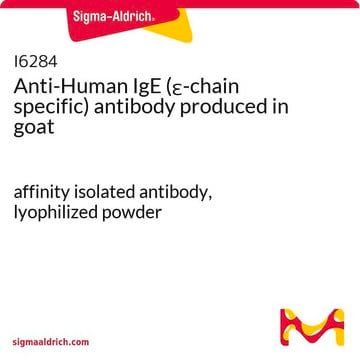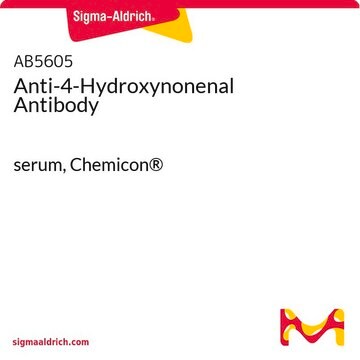MAB2223
Anti-DNP Antibody, clone 9H8.1
clone 9H8.1, from mouse
Synonyme(s) :
Dinitrophenol
Se connecterpour consulter vos tarifs contractuels et ceux de votre entreprise/organisme
About This Item
Code UNSPSC :
12352203
eCl@ss :
32160702
Nomenclature NACRES :
NA.41
Produits recommandés
Source biologique
mouse
Niveau de qualité
Forme d'anticorps
purified immunoglobulin
Clone
9H8.1, monoclonal
Réactivité de l'espèce (prédite par homologie)
all
Technique(s)
western blot: suitable
Isotype
IgG1κ
Conditions d'expédition
wet ice
Modification post-traductionnelle de la cible
unmodified
Description générale
Dinitrophenol (DNP) is a small water-soluble, hydrophobic ligand that binds to transthyretin at acidic pH and also reduces the formation of amyloid fibril. DNP levels of 100 mg/l or more is greatly toxic to acclimated bacteria. DNP has been associated with possible therapies for neurodegenerative and neurological disorders.
Spécificité
Demonstrated to react with a DNP moiety in a wider range of species. This antibody′s reactivity is expected to be species independent.
Immunogène
KLH-conjugated DNP
Application
This Anti-DNP Antibody, clone 9H8.1 is validated for use in WB for the detection of DNP.
Qualité
Evaluated by Western Blot in Oxyblot protein standards.
Western Blot Analysis: 0.5 µg/mL of this antibody detected DNP on 10 µg of Oxyblot protein standards.
Western Blot Analysis: 0.5 µg/mL of this antibody detected DNP on 10 µg of Oxyblot protein standards.
Description de la cible
Various kDa observed. The Oxyblot protein standards (S7151) were used to test this antibody. These standards are phosphorylase B, BSA, OVA, Carbonic Anhydrase, and trypsin inhibitor which all contain 1-3 DNP residues per protein.
Forme physique
Format: Purified
Remarque sur l'analyse
Control
Oxyblot protein standards
Oxyblot protein standards
Code de la classe de stockage
12 - Non Combustible Liquids
Classe de danger pour l'eau (WGK)
WGK 1
Point d'éclair (°F)
Not applicable
Point d'éclair (°C)
Not applicable
Certificats d'analyse (COA)
Recherchez un Certificats d'analyse (COA) en saisissant le numéro de lot du produit. Les numéros de lot figurent sur l'étiquette du produit après les mots "Lot" ou "Batch".
Déjà en possession de ce produit ?
Retrouvez la documentation relative aux produits que vous avez récemment achetés dans la Bibliothèque de documents.
Les clients ont également consulté
Rita Araújo et al.
Bone, 158, 116355-116355 (2022-02-14)
Diabetes mellitus (DM) embrace a group of chronic metabolic conditions with a high morbidity, causing deleterious effects in different tissues and organs, including bone. Hyperglycemia seems to be one of the most contributing etiological factors of bone-related alterations, altering metabolic
Linda Adzigbli et al.
Scientific reports, 14(1), 9658-9658 (2024-04-27)
Sessile benthic organisms like oysters inhabit the intertidal zone, subject to alternating hypoxia and reoxygenation (H/R) episodes during tidal movements, impacting respiratory chain activities and metabolome compositions. We investigated the effects of constant severe hypoxia (90 min at ~ 0% O2 ) followed
Jennifer B M Steffen et al.
The Journal of experimental biology, 226(15) (2023-07-20)
Coastal environments commonly experience fluctuations in salinity and hypoxia-reoxygenation (H/R) stress that can negatively affect mitochondrial functions of marine organisms. Although intertidal bivalves are adapted to these conditions, the mechanisms that sustain mitochondrial integrity and function are not well understood.
Lona Zeneyedpour et al.
International journal of molecular sciences, 23(9) (2022-05-15)
We investigated the feasibility of detecting the presence of specific autoantibodies against potential tumor-associated peptide antigens by enriching these antibody-peptide complexes using Melon Gel resin and mass spectrometry. Our goal was to find tumor-associated phospho-sites that trigger immunoreactions and raise
Jennifer B M Steffen et al.
The Journal of experimental biology, 224(21) (2021-10-27)
Oxygen fluctuations are common in marine waters, and hypoxia-reoxygenation (H-R) stress can negatively affect mitochondrial metabolism. The long-lived ocean quahog, Arctica islandica, is known for its hypoxia tolerance associated with metabolic rate depression, yet the mechanisms that sustain mitochondrial function
Notre équipe de scientifiques dispose d'une expérience dans tous les secteurs de la recherche, notamment en sciences de la vie, science des matériaux, synthèse chimique, chromatographie, analyse et dans de nombreux autres domaines..
Contacter notre Service technique











